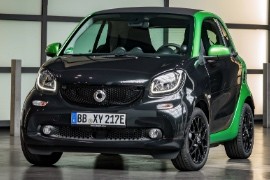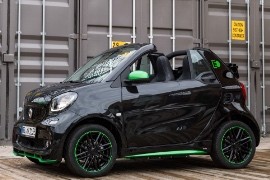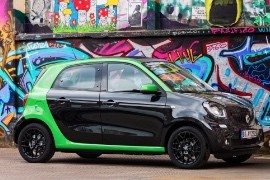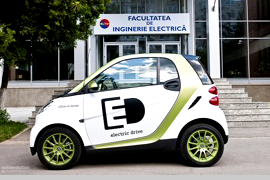SMART Electric Drive Models/Series Timeline, Specifications & Photos
First production year: 2012
Engines: Electric
Body style: Hatchback
The German automaker SMART introduced an electric version of its smallest vehicle, the fortwo, in the autumn of 2016 at the Paris Motor Show and started sales in the same year in the U.S. and in Europe in 2017.
Mercedes-Benz still owned the brand when it introduced the third generation of the tiny two-door vehicle. Only this time, it worked closely with Renault to share the development costs. In addition, it benefited from the French automaker's experience in electric vehicle construction, so the fortwo also got an electron-powered version.
From the outside, the electric version of the fortwo featured the same shape as the internal-combustion-engined sibling with a very short front. Strangely, the automaker kept a mesh grille even though it didn't need that much cooling area. Moreover, the motor was in the back. The big bumper featured fog lights on its outer lower sides. From the side, as in the first SMART ForTwo generation, the safety cell featured a different color than the rest of the car's panels.
Inside the car, there were two seats, as usual, but with plenty of room for the occupants. An unusual design for the dashboard showed a speedometer in front of the driver and two additional gauges on top of it in the middle. On the center stack, an optional infotainment touchscreen was installed. The small trunk space could have been extended by folding down the passenger seat seatback.
Unlike its IAC brother, the electric-powered version received a 60 kW (80 hp) motor fed by a 17.6 kWh battery pack. That package was enough for the daily travels of most customers since the car could cover 99 miles (110 km) on a single charge. In addition, it could've been charged from zero to 100% in just a few hours from a regular, 7kWh wall-box.
In 2014, Mercedes-Benz introduced the third generation of SMART Fortwo on the market with internal combustion engines for specific markets and with an electric motor in 2016.
For the third generation of the SMART, Mercedes-Benz allied with Renault and built an electric version for its city vehicle. Previously, it offered other electric drive solutions since 2007, but the real deal came in 2009 when the orders for an electric-powered SMART reached 2000 units, twice as much as the carmaker estimated. In 2016, the German carmaker introduced the open-top version and offered it with an electric motor.
While most of the convertibles need more room to host the roof when it's retracted, the SMART fortwo Cabriolet doesn't. It just used the area above the trunk. It was more of a targa-cabriolet since it kept the B-pillars in place when the roof was folded. At least, it didn't feature any frame for the side windows. At the front, the electric versions featured a compact mesh-grille. It didn't need to cool any radiator since it didn't feature an internal combustion engine, and there was little need for fresh air to cool the batteries.
The cabin was fit for two occupants offering plenty of legroom. As for the headroom, the sky was the limit. Its high-bolstered seats with integrated headrest were designed for comfortable rides. They were thick and had to compensate the fortwo's short wheelbase. To remind the driver that it is an electric vehicle, it featured air vents surrounded by green trims.
Power came from an 81 hp electric motor fed by a 17.6 kWh lithium-ion battery pack. SMART considered that the 100 miles (160 km) range was enough for regular, city-traffic use.
While for the first generation of the SMART, Mercedes-Benz chose to join forces with Mitsubishi. For the second generation, it shared the platform with Renault.
Mercedes-Benz was a great car-maker for most sorts of vehicles, but when it came to building small city-cruisers, its abilities were limited. Almost anything was smaller than the medium-sized cars were not fighting for top-sellers. On the other hand, Renault was very good at that game, and together, they worked on the second generation of the SMART four-four.
From the outside, it was hard to hide the SMART fourfour connection with the Renault Twingo. But it showed its personality and front fascia with the SMART fourtwo. Even though it featured a hexagonal mesh-grille on between the headlights and in the lower bumper, the motor was in the back.
Inside, there was room enough for four adult passengers. The dashboard was different than the one found on the gasoline-powered versions, with a special dial mounted on top of the instrument cluster featuring the battery charging status and power consumption.
Mercedes-Benz worked together with Renault to built the car. The motor was made by Renault, the batteries by Daimler and the final assembly in Slovakia. The 60 kW motor was fed by a lithium-ion battery pack of 17.6 kWh capacity. That was good for a range of 100 miles (160 km).
The smallest car built by Mercedes-Benz was SMART. The car was produced to cope better with traffic congestion and lack of parking spaces in the European cities. An electric version was introduced in 2012.
The SMART was a purpose-built vehicle. It had to be short enough to be parked perpendicular to the curb and still offer two seats and some trunk for a couple of briefcases in the back. The idea was good and even if the first generation was a big loss for the German car-maker, the project moved on. The electric version was introduced in 2012 and for some, it was the right answer to the same question about price/distance problem.
The design was very similar to the regular SMART ForTwo model. The same short front end with the tiny wheels just inches away from the license plate and a hood that couldn't be opened. The honeycomb grille in the front was just for design purposes since the car didn't have a radiator. In the back, the small tailgate was opened in a split-way fashion and in the lower lid, the car-maker placed the charging cord.
Inside, there was the same SMART ForTwo interior, but with new gauges installed on top of the dashboard. They showed the charging status so the driver won't be left without batteries.
As an electric vehicle, the SMART EV used a 96 hp electric motor placed in the rear, like the gasoline versions. The 17.6 kWh battery pack was stored under the floor, in the same space occupied by the gas tank in the gasoline-powered SMART ForTwo.



